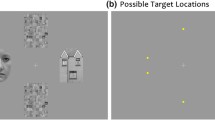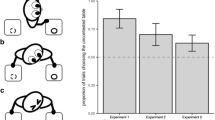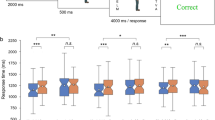Abstract
A number of animal species have evolved the cognitive ability to detect when they are being watched by other individuals. Precisely what kind of information they use to make this determination is unknown. There is particular controversy in the case of the great apes because different studies report conflicting results. In experiment 1, we presented chimpanzees, orangutans, and bonobos with a situation in which they had to request food from a human observer who was in one of various attentional states. She either stared at the ape, faced the ape with her eyes closed, sat with her back towards the ape, or left the room. In experiment 2, we systematically crossed the observer’s body and face orientation so that the observer could have her body and/or face oriented either towards or away from the subject. Results indicated that apes produced more behaviors when they were being watched. They did this not only on the basis of whether they could see the experimenter as a whole, but they were sensitive to her body and face orientation separately. These results suggest that body and face orientation encode two different types of information. Whereas face orientation encodes the observer’s perceptual access, body orientation encodes the observer’s disposition to transfer food. In contrast to the results on body and face orientation, only two of the tested subjects responded to the state of the observer’s eyes.




Similar content being viewed by others
References
Baron-Cohen S (1995) Mindblindness. MIT Press, Cambridge, Mass.
Bugnyar T, Kotrschal K (2001) Deception in ravens. Nature 414:445–446
Call J, Tomasello M (1994) The production and comprehension of referential pointing by orangutans, Pongo pygmaeus. J Comp Psychol 108:307–317
Call J, Bräuer J, Kaminski J, Tomasello M (2003) Domestic dogs (Canis familiaris) take food differentially as a function of being watched. J Comp Psychol 117:257–263
Call J, Hare BH, Carpenter M, Tomasello M (2004) Unwilling or unable: chimpanzees’ understanding of human intentional action. Dev Sci (in press)
Coussi-Korbel S (1994) Learning to outwit a competitor in mangabeys (Cercocebus torquatus torquatus). J Comp Psychol 108:164–171
Emery NJ, Clayton NS (2001) Effects of experience and social context on prospective caching strategies by scrub jays. Nature 414:443–446
Gómez JC (1996) Non-human primate theories of (non-human primate) minds: some issues concerning the origins of mind-reading. In: Carruthers P, Smith PK (ed) Theories of theories of mind. Cambridge University Press, Cambridge, pp 330–343
Goodall J (1986) The chimpanzees of Gombe, patterns of behaviour. Belknap, Cambridge, UK
Hare B, Call J, Agnetta B, Tomasello M (2000) Chimpanzees know what conspecifics do and do not see. Anim Behav 59:771–785
Hare B, Call J, Tomasello M (2001) Do chimpanzees know what conspecifics know? Anim Behav 61:139–151
Hostetter A, Cantero M, Hopkins W (2001) Differential use of vocal and gestural communication by chimpanzees (Pan troglodytes) in response to attentional status of a human (Homo sapiens). J Comp Psychol 115:337–343
Kobayashi H, Koshima S (2001) Unique morphology of the human eye and its adaptive meaning: comparative studies on external morphology of the primate eye. J Hum Evol 40:419–435
Leavens DA, Hopkins WD, Bard KA (1996) Indexical and referential pointing in chimpanzees (Pan troglodytes). J Comp Psychol 110:346–353
Maestripieri D (1996) Gestural communication and its cognitive implications in pigtail macaques (Macaca nemestrina). Behaviour 133:997–1022
Maestripieri D (1997) Gestural communication in macaques. Evol Commun 1:193–222
McKinley J, Sambrook TD (2000) Use of human-given cues by domestic dogs (Canis familiaris) and horses (Equus caballus). Anim Cogn 3:13–22
Miklósi A, Polgárdi R, Topál J, Csányi V (1998) Use of experimenter-given cues in dogs. Anim Cogn 1:113–121
Pika S, Liebal K, Tomasello M (2003) Gestural communication in young gorillas (Gorilla gorilla) gestural repertoire and use. Am J Primatol 60:95–111
Povinelli DJ, Eddy TJ (1996) What young chimpanzees know about seeing. Monogr Soc Res Child Dev 61:152
Reaux JE, Theall LA, Povinelli DJ (1999) A longitudinal investigation of chimpanzees’ understanding of visual perception. Child Dev 70:275–290
Theall LA, Povinelli DJ (1999) Do chimpanzees tailor their gestural signals to fit the attentional states of others? Anim Cogn 2:207–214
Tomasello M (1996) Chimpanzee social cognition. Monogr Soc Res Child Dev 61:161–173
Tomasello M (1997) The ontogeny of chimpanzee gestural signals. Evol Commun 1:224–259
Tomasello M, Call J, Nagell K, Olguin R, Carpenter M (1994) The learning and use of gestural signals by young chimpanzees: a trans-generational study. Primates 35:137–154
Acknowledgements
We thank the caretakers of the Wolfgang Köhler Primate Research Center in the Leipzig Zoo, Leipzig, Germany, for their help in collecting the data and several anonymous reviewers for their comments on an earlier version of this manuscript. The reported experiments comply with all laws of the country in which they were performed.
Author information
Authors and Affiliations
Corresponding author
Rights and permissions
About this article
Cite this article
Kaminski, J., Call, J. & Tomasello, M. Body orientation and face orientation: two factors controlling apes’ begging behavior from humans. Anim Cogn 7, 216–223 (2004). https://doi.org/10.1007/s10071-004-0214-2
Received:
Revised:
Accepted:
Published:
Issue Date:
DOI: https://doi.org/10.1007/s10071-004-0214-2




